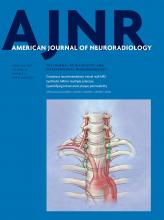Index by author
Stellmann, J.-P.
- ADULT BRAINYou have accessT1 Recovery Is Predominantly Found in Black Holes and Is Associated with Clinical Improvement in Patients with Multiple SclerosisC. Thaler, T.D. Faizy, J. Sedlacik, B. Holst, K. Stürner, C. Heesen, J.-P. Stellmann, J. Fiehler and S. SiemonsenAmerican Journal of Neuroradiology February 2017, 38 (2) 264-269; DOI: https://doi.org/10.3174/ajnr.A5004
Sturner, K.
- ADULT BRAINYou have accessT1 Recovery Is Predominantly Found in Black Holes and Is Associated with Clinical Improvement in Patients with Multiple SclerosisC. Thaler, T.D. Faizy, J. Sedlacik, B. Holst, K. Stürner, C. Heesen, J.-P. Stellmann, J. Fiehler and S. SiemonsenAmerican Journal of Neuroradiology February 2017, 38 (2) 264-269; DOI: https://doi.org/10.3174/ajnr.A5004
Suzuki, M.
- FELLOWS' JOURNAL CLUBADULT BRAINOpen AccessSynthetic MRI in the Detection of Multiple Sclerosis PlaquesA. Hagiwara, M. Hori, K. Yokoyama, M.Y. Takemura, C. Andica, T. Tabata, K. Kamagata, M. Suzuki, K.K. Kumamaru, M. Nakazawa, N. Takano, H. Kawasaki, N. Hamasaki, A. Kunimatsu and S. AokiAmerican Journal of Neuroradiology February 2017, 38 (2) 257-263; DOI: https://doi.org/10.3174/ajnr.A5012
In this retrospective study, synthetic T2-weighted, FLAIR, double inversion recovery, and phase-sensitive inversion recovery images were produced in 12 patients with MS after quantification of T1 and T2 values and proton density. Double inversion recovery images were optimized for each patient by adjusting the TI. The number of visible plaques was determined by a radiologist for a set of these 4 types of synthetic MR images and a set of conventional T1-weighted inversion recovery, T2-weighted, and FLAIR images. Conventional 3D double inversion recovery and other available images were used as the criterion standard. Synthetic MR imaging enabled detection of more MS plaques than conventional MR imaging in a comparable acquisition time (approximately 7 minutes). The contrast for MS plaques on synthetic double inversion recovery images was better than on conventional double inversion recovery images.
Syed, F.H.
- EDITOR'S CHOICEADULT BRAINOpen AccessQuantifying Intracranial Plaque Permeability with Dynamic Contrast-Enhanced MRI: A Pilot StudyP. Vakil, A.H. Elmokadem, F.H. Syed, C.G. Cantrell, F.H. Dehkordi, T.J. Carroll and S.A. AnsariAmerican Journal of Neuroradiology February 2017, 38 (2) 243-249; DOI: https://doi.org/10.3174/ajnr.A4998
The purpose of this study was to use DCE MR imaging to quantify the contrast permeability of intracranial atherosclerotic disease plaques in 10 symptomatic patients and to compare these parameters against existing markers of plaque volatility using black-blood MR imaging pulse sequences. Ktrans and fractional plasma volume (Vp) measurements were higher in plaques versus healthy white matter and similar or less than values in the choroid plexus. Only Ktrans correlated significantly with time from symptom onset. Dynamic contrast-enhanced MR imaging parameters were not found to correlate significantly with intraplaque enhancement or hyperintensity. The authors suggest that Ktrans may be an independent imaging biomarker of acute and symptom-associated pathologic changes in intracranial atherosclerotic disease plaques.








